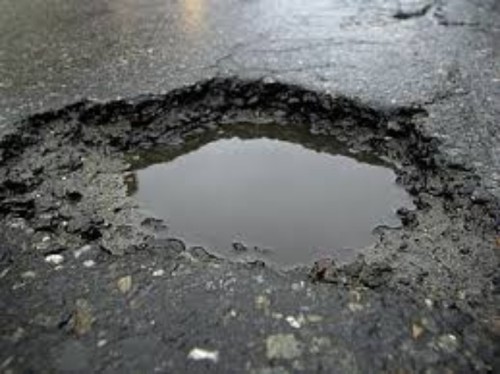
By RICK BRUNDRETT
Despite reduced traffic in South Carolina over the past two months resulting from government-ordered shutdowns, a state surplus under the 2017 gas-tax-hike law continued to grow while most major paving projects went unfinished, newly released records show.
Through April 30, the state collected $1.2 billion under the law, which could cover nearly 90% of the total estimated cost of project “commitments” statewide, according to S.C. Department of Transportation records.
Yet the total dollar amount of completed “pavements” projects was less than 43% of the overall estimated $921.1 million cost of all such projects as of the end of April, The Nerve’s review found. And the 3,422 miles of roads that DOT has designated for repairs represent just over 10% of the state-maintained roads that the agency says needs to be repaved or rebuilt.
A DOT official on Thursday estimated the state could lose $293 million in gas and car sales tax revenue over the next two years as motorists traveled less because of restrictions imposed after the coronavirus outbreak, The State newspaper reported.
But a special state fund created with the gas-tax-hike law had a surplus of more than $570 million as of the end of April, a growth of about 3.7% from March 31, and which represented more than 47% of total collected revenues, The Nerve’s review found.
The $570.1 million surplus as of April 30 was nearly $43.5 million larger than the total amount of vendor payments for completed work, DOT records show.
In passing the gas-tax-hike law, which raised the state gas tax 12 cents over six years and increased other vehicle taxes and fees, lawmakers promised the money would go toward fixing the state’s crumbling roads and bridges. But as The Nerve has repeatedly pointed out, DOT has completed relatively small percentages of major repaving or road construction projects statewide since the law took effect July 1, 2017.
The South Carolina Policy Council, the parent organization of The Nerve, has contended the gas-tax-hike law was written in a way to allow DOT to divert revenues to the State Transportation Infrastructure Bank (STIB) to pay off bond debt. The STIB over the years funneled several billion dollars to major construction projects in select counties.
DOT has said 80%, or 33,600 miles, of the state’s approximately 42,000 miles of roads needs resurfacing or rebuilding. The agency also identified 465 out of 750 “structurally deficient” bridges to be replaced.
But of the $1.34 billion in project “commitments” listed by the agency as of April 30, nearly $259 million, or more than 19% of the total, was designated for interstate widenings, DOT records show.
Sen. Hugh Leatherman, R-Florence, last year created a special Senate panel, called the “Special Interstate Subcommittee,” to study accelerating interstate expansion. Leatherman is chairman of the budget-writing Senate Finance Committee and also sits on the STIB board.
Since July 1, 2017, the state gas tax has increased by a total of 6 cents; another 2-cent hike is set for this July 1. DOT records show $364 million in deposits from the increased gas taxes as of April 30, a jump of nearly $6.6 million from March 31, though less than the $15.5 million in additional collections from Feb. 29 to March 31.
The Nerve’s review of DOT records found that as of April 30, the total dollar amount of completed “pavements” projects compared to the collective estimated cost of all such projects in the state’s 46 counties ranged from 8.1% in Calhoun County to 77.2% in Jasper County. The statewide completion percentage averaged 42.5%.
Thirty-one counties had completion rates lower than 50 percent, including the larger counties of Greenville (49.8%), Richland (47.1%), Lexington (45.3%), Horry (29.8%) and Charleston (29.1%).
Following is a list of 18 counties in which the total dollar amount of completed “pavements” projects was less than 40% of the collective projected cost of all such projects in those counties:
- Kershaw: $5.2 million (39.5%);
- Lancaster: $9.4 million (37.5%);
- Marlboro: $3.9 million (36.1%);
- Aiken: $8.6 million (35.93%);
- Allendale: $2.7 million (35.91%);
- Hampton: $3.1 million (34.7%);
- Oconee: $7.7 million (33.5%);
- Lee: $2.4 million (32.8%);
- Anderson: $14.3 million (32.5%);
- Horry: $20.4 million (29.8%);
- Charleston: $8.7 million (29.1%);
- Darlington: $3.8 million (26.9%);
- Newberry: $4.6 million (26.7%);
- Chesterfield: $7.3 million (25.6%);
- Pickens: $5.1 million (21.5%);
- Orangeburg: $3 million (11.2%);
- Georgetown: $2.7 million (10.4%);
- Calhoun: $628,802 (8.1%)
Brundrett is the news editor of The Nerve (www.thenerve.org). Contact him at 803-254-4411 or rick@thenerve.org. Follow him on Twitter @RickBrundrett. Follow The Nerve on Facebook and Twitter @thenervesc.
Nerve stories are free to reprint and repost with permission by and credit to The Nerve.
